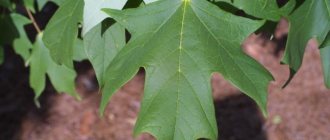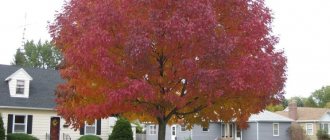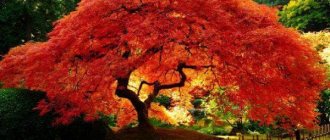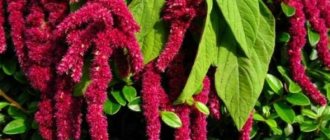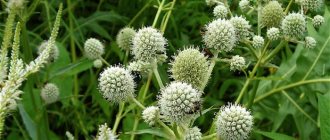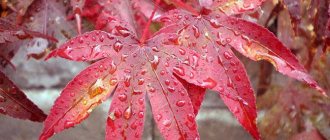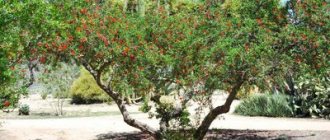Botanical description of varieties
Silver maple is close to red maple, and can form hybrid varieties with it. Its leaves are five-lobed, 8 cm long. Their upper part is painted green, and the lower part is silver.
Monoecious small flowers, collected in panicles, bloom in March or April. The fruits of silver maple are large; each wing can be up to 50 mm long. They ripen at the end of May, falling to the ground and sprouting immediately. The tree is planted in city parks; due to its rapid growth and ease of care, it is popular.
The famous variety Laciniatum Vieri is distinguished by drooping branches and an asymmetrical crown. Its leaves are more openwork, they are more cut than those of the main species. Their color is bronze in spring, pale green in summer, and yellow in autumn. The maximum tree height is 20 m, the average is about 10 meters.
In addition to Laciniatum Wieri, there are other decorative forms of maple:
- variegated - the leaves are not divided into lobes;
- tripartite - leaf plates consist of three blades;
- weeping;
- pyramidal.
An interesting variety is Lutescens with yellow foliage. This tree grows up to 7 meters in height in the first 30 years. It can freeze in winter, so it is more suitable for growing in the southern regions. In the spring, when they bloom, the leaves of the maple are orange or bronze, then turn yellow.
Varieties and varieties
There are many types of culture. However, only a few plant species are common in our country and in Europe:
- Red maple. It differs from other species in a special decorative feature: the leaves have a reddish tint. This is especially noticeable in the fall, when the entire crown turns red or fiery orange. The leaves have a special shape: the plate is divided into 5 lobes with a pointed edge. The length of the leaves is up to 11 centimeters. The crown has a pyramidal or elliptical shape. Red maple is used in the design of city parks and alleys. The spreading crown allows you to quickly create a natural corridor. It is possible to plant a tree as an individual object.
- Silver maple. The culture is widespread in North America, however, it is often found in Russia. The main difference can be considered the color of the foliage: the top is dark green, and the lower back side is silvery. The inner side of the leaf has a velvety surface. The height of an adult tree is up to 40 meters, the crown diameter is up to 20 meters. Thanks to their silvery crown, trees of this type are used in the design of public gardens, gardens and parks.
- Laciniatum Vieri is a low-growing tree species. Its height does not exceed 15 meters. The crown has an asymmetrical shape. The leaves are thin with an openwork texture. In summer, the foliage is green with silver speckles (the back of the leaf is silver), but in autumn it is bright lemon in color.
- Bonsai. In principle, it cannot be considered a separate species. This is a form of growing a tree using a special technology. It is the Canadian maple that is successfully used for growing miniature Bonsai trees. The species has decorative characteristics: beautiful inflorescences and leaves, bright color. Growing a maple tree in a pot is a very painstaking task, however, with proper care, the result will be worth it.
Any of the varieties will decorate the garden. But it is worth remembering that this is a large plant that requires space. Before planting, it is worth considering the growing conditions, providing the plant with sufficient space to grow.
Habitat of silver maple
The silver maple (Acer saccharinum) is native to eastern North America, the USA and Canada. It prefers moist, light soils, river banks and ponds, and rarely grows in dry places.
The tree is adapted to long-term flooding of the soil, tolerates it easily, and does not tolerate shading. Grows well in any area where there is sufficient moisture, especially in warm Mediterranean climates.
Country ideas and experience of gardeners
The sugar maple originates from North America: it is widespread in the eastern United States and Canada; the maple leaf is present on the Canadian flag. But this tree soon took root both in Europe and in the Russian Federation; it is seen everywhere in temperate latitudes. Sugar maple wood is highly prized because it has dozens of uses and is highly dense and durable.
Additionally, the popularity of the tree is increased by its ability to produce sweet maple sap.
- A layman's description of the sugar maple
- Varieties
- Landing
- Conditions for growing maple
- Uses of Sugar Maple
Planting maple in open ground
Maple seedlings with an open root system are planted in open ground in the spring. When planted in the summer heat, the maple will suffer from overheating of the root system, and in the fall it may freeze. For a container plant, planting time does not matter much; it can be any warm day of the growing season, except winter.
It is important to choose a place for planting that is protected from strong draft winds; fragile maple branches easily break off. The young tree should have light; in the shade of a building or other trees it will be uncomfortable; diseases and pests can overcome it.
An adult tree will take up a large living space, so the seedling is placed at a distance of at least 4 m from other trees and shrubs. Maple is undemanding in terms of soil type, grows well on sandy and loamy, slightly acidic soils, and loves an abundance of humus. Leaf and turf soil, humus, peat and sand are added to the planting hole; a drainage of crushed stone and sand, 15 cm high, is made at the bottom.
A seedling brought from a garden center is planted in a prepared hole. The root collar is not buried when planting; it should remain at soil level. After planting, the maple is watered and mulched around the trunk using sawdust or dry soil.
Watering
In the first years of life, young plants need to be watered abundantly. One seedling needs at least twenty liters of water per month. In extreme heat, the amount of watering is increased.
As the plant develops, it can be watered less often, but maple grows better with good soil moisture, which is why it loves watering.
To prevent the soil around the plant from drying out, you can mulch. Peat or moss is used for this.
Maple is one of the plants that is easy to care for and grows well in any type of soil. It is practically not susceptible to disease, but the tree needs to be treated for pests. To do this, use various drugs offered in country stores. Most often, maple is affected by whiteflies, aphids, and weevils.
Agricultural cultivation technology and care
Cultivation of maple will not require any special agrotechnical measures. This strong and unpretentious tree grows quickly even without fertilizers and seasonal pest control treatments.
You need to pay attention to watering; maple does not like the soil to dry out. The soil must be loose, so after watering the tree trunk circle is loosened and mulched.
To increase decorativeness, complex mineral fertilizer is applied - with a predominance of nitrogen in the spring and potassium-phosphorus from mid-summer. It is enough to carry out 3-4 feedings per year.
Care Tips
Tip 1. Observe the frequency of watering
| |
Tip 2. Feed the tree
| |
Tip 3. Periodically loosen the tree trunk circle
| |
Tip 4. Protect the plant from pests and diseases
|
Pruning and crown formation
The silver maple has fragile branches; they are often broken off by strong winds and snow accumulated in winter. It is advisable to carry out annual sanitary pruning, removing all damaged parts of the shoots.
If it is necessary to restrain the rapid growth of a tree, formative pruning of the crown is carried out, shortening the top and side branches.
All types of pruning are done in the spring before the sap begins to flow (about 2 weeks before the buds open) or in the fall, when there is no frost, but the foliage has already fallen. If the air temperature is below 0 °C, the tree is not touched.
Application in landscape design
Silver maple is used for single plantings on the lawn and creating park alleys. It is appropriate to plant it on the banks of water bodies, as it loves moist soil.
Maple grows quickly in the first years after planting, creating shade in open areas for shelter from the summer heat. With its help, you can create picturesque landscape compositions by planting it next to red maple, birch, willow or mock orange.
Top dressing
The next year after planting, the maple needs to be fed. To do this, make a mixture of:
- potassium fertilizer – 20 g;
- nitrogen fertilizer – 50 g;
- superphosphate – 50 g.
Mix everything, then prepare the soil around the maple for applying fertilizer. To do this, dig up the soil with a shovel to a depth of at least ten centimeters. Then dry fertilizers are added to the soil and embedded into the soil with a shovel. When watering, the granules will dissolve and nourish the tree.
Description of silver maple
Silver maple is a tall, spreading tree. The height of an adult plant is from 25 to 40 meters. At a young age, the tree grows very actively and annually gains about a meter in height.
More mature trees grow 30–40 centimeters in height and 20–30 centimeters in width every year. The crown of the tree is openwork, has a spherical or cylindrical shape.
The tree trunk is short but powerful - its girth reaches one and a half meters. At a height of 1-1.5 meters, the trunk begins to branch and divides into several powerful branches. They serve as the basis for the crown of the entire tree.
The color of the bark covering the branches-trunks changes throughout the life of the plant. Young trees have light gray, smoky bark. As the plant matures, the bark darkens, acquiring a brownish-gray tint. Cracks, wrinkles and scales appear on it. Numerous shoots extend from the base branches.
At the base they are slightly drooping, but at the edges of the crown the shoots of the tree change the direction of growth and rush upward. Young branches are colored reddish-brown, while more mature ones have a silvery tint.
The branches have leaf scars similar to those found on red maple. They also have five-lobed, deeply dissected leaves. The length of the leaves ranges from 8 to 16 centimeters, width – 6 – 12 centimeters.
The upper part of the leaf is green, and the back side is silvery, slightly bluish. Due to the unusual color of the branches and leaves, the entire crown of the tree acquires a light silvery tint.
It is this feature that explains the unusual name of silver maple. Another name for this plant is white maple, which is also associated with the color of its crown. In autumn, it takes on a golden, orange-yellow or red color. In late autumn, the leaves of the plant fall off. The root system has a taproot character.
The main root goes deep, and branching processes of lateral roots lie on the surface of the soil. In general, the plant's root system is not very deep. This allows it to grow in waterlogged and even swampy soils, as well as in places with little soil. Thus, maple shoots can be seen on the roofs of abandoned houses or in the middle of a destroyed road.
Silver maple is a long-lived plant. Its lifespan reaches 100, or even 150 years. Silver maple blooms in mid-spring, several weeks before the leaves appear. The flowers are small, up to 0.7 centimeters in diameter, have a red-green tint and are collected in small inflorescences. And already at the end of May - beginning of June, fruits appear on the plant - the so-called “lionfish”.
They have two identical wings, each 3–3.5 centimeters long and 1–1.5 centimeters wide. Silver maple not only produces abundant fruit, but also has the largest fruits among all northern maple species.
Due to their large weight, they cannot always be moved by air currents, and therefore are often carried by currents. This is another reason why, in the wild, silver maple grows along the banks of reservoirs.
Many birds and small mammals feed on the fruits of silver maple and ash maple: squirrels, hares, chipmunks and beavers. Some of them eat not only the seeds, but also the buds of this plant.
A layman's description of the sugar maple
Sugar maple, also known as Canadian maple, is a deciduous tree more than 40 meters high. It lives for a very long time: the lifespan of the Canadian maple reaches 400 years. Maple prefers places that are well lit by the sun or partial shade; it reproduces with the help of seeds.
The bark of a young tree has a light gray or light brown tint; over the years it begins to darken.
The maple has wonderful roots; the older the tree, the more remarkable and branched its root complex becomes.
Maple is characterized by a dense, spreading crown. The leaves are simple, they are located opposite on the branches. The leaf blades have a characteristic curly shape; they look especially beautiful and unusual in the canopy, at a time when the leaf receives a rich red or yellow tint.
The tree is deciduous; in the autumn months it completely sheds its leaves.
The tree blooms in spring: small yellow-green flowers appear on the branches, collected in clusters. The fruit of the plant is a lionfish; each lionfish contains 2 seeds. Most trees are dioecious, with male and female flowers on the same plant.
Sugar maple took its name from its ability to produce sweet maple sap, from which sugar and maple syrup are made.
Features of maple planting
Under natural conditions, silver maple actively reproduces using seeds. As soon as a plant seed hits the soil, it begins to germinate. Already in the first day after falling into the soil, sprouts appear on the seed.
The only necessary condition for germination is sufficient soil moisture. In dry soil, seeds are unlikely to sprout.
To grow silver maple, you need to choose a well-lit area with fertile, moist soil. Such conditions are also suitable for another species - small-leaved maple.
An adult plant is not afraid of rainy periods, swampy soil and even frosts. Young shoots may suffer from a strong drop in temperature.
It is recommended to plant the collected seeds almost immediately. This way, by the time the autumn cold comes, the plant will have time to take root and get stronger. In addition, this planting regime corresponds to the natural growth conditions of the plant.
Application of silver maple
White, or silver, maple is, first of all, an ornamental plant. It tolerates polluted and gassed urban environments well, and therefore is used for landscaping city parks, gardens and alleys.
It is often grown along the banks of reservoirs, as it feels very comfortable near water. The unusual appearance of the plant allows it to be used both in group and single plantings. The crown, cast in a silvery color, makes an interesting combination with coniferous plants: spruce, fir and juniper.
Silver maple also looks good against the background of buildings painted in bright, contrasting colors. Therefore, it is often used for landscaping city courtyards and squares.
The benefits of silver maple lie not only in its decorative appearance. Furniture is made from maple wood. And the juice of this plant is used in cooking to produce maple syrup, sugar and even beer. Due to the high sugar content in silver maple sap, it is also called silver maple.
For your information, we suggest you read another article about Norway maple by following the link.
Scope of application
Maple is not only an ornamental tree. The scope of its application is not limited to design.
Canadian maple is used in the construction and furniture industries. It has valuable wood. It is not inferior in strength to oak. The most popular exclusive application is the production of luxury maple parquet. This material has a beautiful shade, has high strength and wear resistance.
Maple can also become a raw material for food. For example, there is a popular maple syrup used by confectioners. Sugar is used in European cuisine to prepare traditional dishes and desserts.
And, of course, the main area of application is landscape design. Maple is actively bred by breeders for use in the design of individual plots, city parks and public gardens, and recreation areas. Despite the fact that maple grows very slowly, it is a fairly popular ornamental crop.
Biological description of the tree
Cylindrical or round in shape and a wide and sparse crown is formed by drooping branches. At the beginning of tree development, the branches rush downward, and then, heading upward, they bend beautifully in an arched shape.
The branches are equipped with V-shaped leaf scars (exactly the same as the red maple). True, silver maple branches are stronger, often colored dark brown, and when broken they emit an unpleasant odor. Young trees have bright red branches, while mature trees have silver-gray branches.
The length of the opposite five-lobed leaves, deeply dissected on top, green, bluish-silver on the bottom, is 8-16 cm, and the width is 6-12 cm. In autumn, the foliage blazes with yellow-golden and orange colors.
Young specimens are covered with smoky gray smooth bark. As trees mature, the bark darkens and is covered with long, narrow, flaky scales. Silver maple has a taproot system. Lateral roots, branching, form a superficial fibrous system.
Canadian maple - Acer saccharum
The Canadian maple tree has two classifications: Maple or Sapindaceae family. Its botanical name is Canadian maple or sugar maple. The ancestral home of the Canadian maple is considered to be North America, namely Canada and the eastern part of the USA, where it is most widespread. The maple leaf is a symbol of Canada and occupies a large part of its flag. However, this tree has taken root well in Russia, in its European part.
Description of Canadian maple
This tree has surpassed even oak in terms of its strength and is widely used in furniture production. Thanks to its density and fine-pored structure, maple wood has a beautiful pattern that forms narrow dark heart-shaped rays. Canadian maple boards are perfect for making parquet, which, due to its special texture, has a natural and natural look and immerses you in the world of nature, and also has the ability to acquire a pink or light yellow tint and pearlescent color depth. Any room looks spacious and acquires a feeling of lightness due to the light texture of maple wood.
This wood is widely used in many industries, such as: interior decoration, flooring, plywood and musical instruments, sports equipment and household items. The importance of maple in nature cannot be underestimated. Bark, leaves, and wood are important sources of food for wild animals. Birds build comfortable nests for their offspring on tree branches.
Description of Canadian maple
It is a tree with a maximum height of 40 m and a lifespan of 300 to 400 years. It grows in places illuminated by the sun or in partial shade, requires moderate watering and is propagated by seeds. Has a thick, voluminous crown; rough, fissured light gray or gray-brown bark, darkening over the years; shiny smooth red-brown branches. Has a powerful root system.
The maple leaf is simple opposite, supported on a petiole 5 to 11 cm long. The edges of the leaf are jagged and rough, the top is smooth and dark green, the bottom is slightly rough and pale. The leaf width also reaches from 5 to 11 cm. The maple leaf acquires a special charm in the fall, repainting in various shades. Since the maple sheds its leaves in the fall, it is called deciduous.
Canadian maple leaves
In spring, the tree goes through a flowering phase. Maple flowers are small in size, greenish-yellow in color, held on a long petiole and collected in a cluster of 8 to 14 flowers. Most trees are dioecious. This means that they can have separately male or female flowers, but sometimes have both sexes together on the same trunk but on different branches. The maple has a lionfish-shaped fruit sitting on a red or red-brown petiole. The lionfish has two seeds, the length of which reaches from 2 to 2.5 cm. The color is very bright.
The tree is frost-resistant, however, it is sensitive to gusty winds, severe frosts and hail, which can cause irreparable damage to the plant. Therefore, young seedlings in the first years of life must be wrapped when frost occurs.
Maple seedlings
Annual seedlings or seeds allow you to grow maple seedlings. Annual seedlings will take root easier and faster. The seedlings are placed in a container with a sufficient amount of soil, which promotes the growth and development of young shoots. Loose soil with the possibility of air penetration into it is best suited.
Caring for seedlings is easy. Until the plant gains strength, it needs to be fertilized, fed with mineral supplements and microelements. A young plant needs constant watering, but as it dries out. It is best to plant seedlings in the ground in spring or September, in which case they take root better. But first it is necessary to create conditions for “getting used to” natural conditions by taking containers with seedlings out into the air for a certain time.
Planting a seedling occurs by placing it in a hole measuring 50 cm. If several plants are planted, it is better to place them at a distance of two meters. The seedling is placed in the middle of the hole so that the trunk is immersed no more than 5 cm deep. After planting, the tree is watered with at least 15 liters of water.
Types of Canadian maple
Red Canadian maple
It gets its name from its leaves, which can be red, purple or burgundy. The leaf is up to 11 cm long and has 5 small pointed teeth. The inflorescences of red maple are different: small, with a diameter of 3 to 5 mm, with dark green stamens and connective tissue, yellow-green in color, long red pedicels and perianths, round in shape. Red maple foliage can be shaped like a pyramid or an ellipse. Its height can reach from 25 to 40 m. The length of the life cycle is 150-200 years. Grows quickly. Has a bright color.
Canadian maple in garden decor
It is used to decorate gardens, parks, and homestead areas. The color is beautiful. Pairs perfectly with various types of trees and shrubs. Red maple is used to create hedges. The photo shows the Canadian red maple in all its glory.
Flowering and fruiting
The plant is endowed with red-brown buds that cover large scales. Flower buds tend to form conspicuous clusters. Flowering of trees begins in mid-spring, before the leaves bloom. The flowers are greenish-red in color. During the flowering period, the movement of sugary juice suitable for cooking begins.
Lionfish is the name of the silver maple fruit. The fruit of the tree is assembled from two identical wings in which the seeds are hidden. The length of the wings connected in pairs is 3-7 cm, and the width is 12 mm. The ripening time for sickle-shaped lionfish is late spring.
Sugar maple requires high humidity for seed germination. In dry times they lose their germination capacity. Fruits that fall into moist soil immediately germinate. Sprouts may appear within 24 hours. Seeds that fall into moist soil after rain have the best germination rate.
The seeds of this plant are heavy. A pair of wings connected to each other helps them move in space (from here the answer to the question “what is the name of the maple fruit”) becomes obvious. Water flows also play a significant role in the distribution of lionfish, facilitating their movement over long distances.
Popular types of maple
Norway maple
Norway maple is the most popular species, growing 15 - 20 m tall. Frost-resistant. Its trunk is straight and its crown is widely rounded. The leaves of the Norway maple are five-lobed and green. The yellow-green flowers of this maple are collected in corymbs. Blooms at the beginning of foliage.
Norway maple has different varieties: with red foliage - varieties “Rubrum”, “Crimson King”,
“Crimson Faasens Black”
,
“Deborah”
.
With yellow foliage - varieties "Golden Globe"
(when it blooms it is pinkish, and at the end of summer it turns yellow),
"Priceton Globe"
.
With variegated white-green foliage - Norway maple variety "Drummonda"
with forms: white-edged -
Albo Marginata
and variegated -
Albo Variegata
.
Norway maple has a varied crown shape: there are varieties with both spherical “Globosum”
and conical
“Columna”
crown shapes. All of the above varieties of Norway maple are frost-resistant.
Ash maple
Maple is very popular and widespread in urban landscaping. It reaches a height of 20 m. The leaves of the ash-leaved maple are complex, odd-pinnate, reminiscent of ash leaves. The simple form with green foliage is not decorative, but is so durable that it is used in urban landscaping.
A beautiful variegated form is used as an ornamental shrub - the ash-leaved maple "Flamingo"
with whitish-green foliage and pink spots, also species with yellow foliage of several forms
“Aureum-Variegatum”
- golden-variegated and
“Aureum-Marginatum”
golden-edged.
“Auratum”, “Elegance”
and other variegated forms are also decorative
Ash maple varieties are very winter-hardy. There are varieties of this maple that do not bloom. Ash maple propagates by cuttings and grafting. There are other forms with purple foliage, silver-variegated leaves and fluffy twigs or curly foliage.
Tatarian maple
Tree or shrub 10 m in height, rounded crown. The foliage of the Tatarian maple is toothed and ovate. In autumn with red or yellow color. Tatarian maple is very decorative during the flowering period - inflorescences with cream or white flowers.
It has a beautiful shape with red leaves in autumn. Winter-hardy. Tatarian maple propagates by cuttings and seeds. Shade-tolerant.
Falsebold maple
The false siebold maple is one of the most decorative maples, 8 m tall, the foliage is delicately indented, palmate, green, in the fall it is yellow, then turns pink and red.
Excellent replacement for non-wintering Japanese maple species. Large cream flowers of the false siebold maple are collected in a racemose inflorescence. Shade-tolerant, winter-hardy. Unpretentious. The false siebold maple propagates by cuttings.
Guinnala maple
Tall maple up to 6 m tall. The crown of the ginnal maple is wide. The foliage is leathery, elongated, green, turning red in autumn. Yellow fragrant flowers are collected in inflorescences.
Red or green lionfish are very decorative. The ginnala maple is winter-hardy. Propagates well by cuttings and shoots. Can be trimmed and forms dense hedges.
Field maple
A low tree 10 m tall, with very decorative narrow and small leaves. Not very frost resistant. In the first years it is necessary to cover and mulch.
There are many beautiful forms with purple or variegated leaves. Rarely appears on sale.
Maple mono
The tree is 15 m high, the crown is wide. Maple foliage is mono green and small.
Frost-resistant species, but it is better to cover young seedlings with spruce branches. Mono maple is shade-tolerant. Rarely found on sale.
Silver maple
An ornamental tree 30 m in height with drooping branches and five-lobed leaves, covered with a silvery coating underneath, it looks beautiful when the leaves sway in the wind.
Silver maple is frost-resistant, but after planting for the first time it is better to mulch and cover with spruce branches. It has beautiful forms with rugged foliage - “Viera”, as well as a pyramidal and weeping crown shape. Does not tolerate calcareous soils and groundwater.
Growing Silver Maple
Silver maple grows well in fertile areas with good drainage. It needs a well-lit place with well-moistened, fine-textured soil. On sufficiently moist soil, trees take root easily. They have average tolerance to saline soils. Due to its ability to exist in damp places, the plant can easily withstand prolonged floods. It dominates forest areas, competing with poplar, beech and ash.
Mature trees are resistant to severe winter frosts. Young shoots sometimes freeze over in severe frosts. Trees are not able to withstand the onslaught of powerful winds and excessive snowfall. Their fragile branches break under the influence of adverse natural phenomena.
Sugar maple easily withstands unfavorable environmental conditions. He is not afraid of smoke and gas contamination of air masses. It is suitable for organizing gardening complexes in cities. Sugar maple trees are affected by several pests. They suffer from leaf weevils, whiteflies and mealybugs.
Ash maple
This “American aggressor” has become the most common tree in Moscow and in the cities of Europe and Asia. Today, ash maple can be found on roadsides, along the edges of forests and along river banks. Native trees do not allow it to penetrate into the depths of forests and parks. In terms of the abundance of self-seeding, the ash-leaf maple is almost the absolute champion in its family. However, from this tree, breeders have obtained several very interesting decorative forms that are quite worthy of taking their place in any summer cottage. First of all, this is variegatum with white-green leaves and a somewhat similar flamingo variety, which has bright pink strokes added to the white-green palette.
Decorative properties of maple
Silver maple has several varieties. It can be variegated, tripartite and pyramidal. In addition, there is a weeping form and the Viera variety. Trees differ in the shape of their leaves and branches.
The height of the pyramidal maple does not exceed 20 meters. Vertical branches form a columnar wide crown. Autumn foliage burns deep red. The Vieri maple has a spreading crown covered with greenish-silver leaves. Its fragile branches have increased fragility. The Borns Graciosa variety is endowed with a light crown, studded with huge rugged leaves. The height of the trees does not exceed 15 meters.
